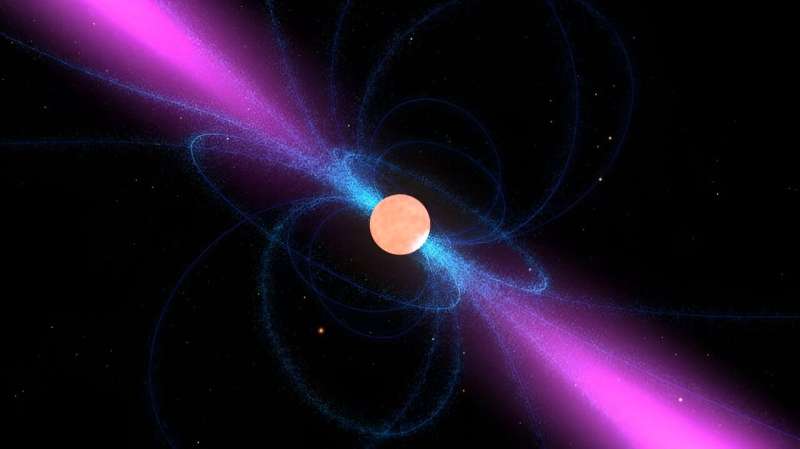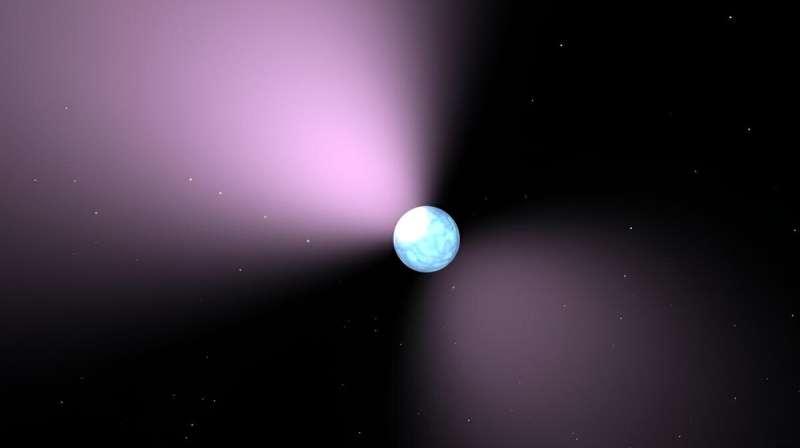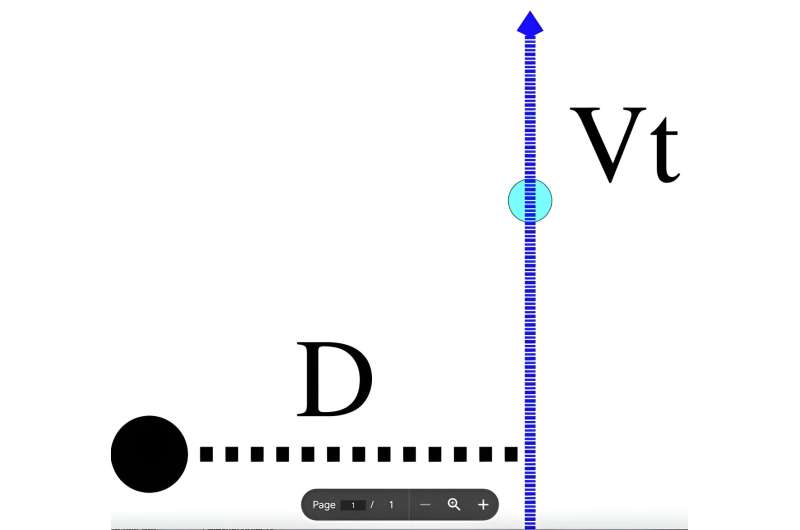
This image shows an artist’s impression of a neutron star, surrounded by its strong magnetic field (blue). It emits a narrow beam of radio waves (magenta) above its magnetic poles. When the rotation of the star sweeps these rays across the Earth, the neutron star can be detected as a radio pulsar. Credit: NASA Goddard/Walt Feimer, Attribution (CC BY 4.0)
Exciting evidence of possible dark matter objects has been discovered with the help of the “clocks” of the universe. These pulsars—orbiting neutron stars that emit lighthouse-like radio wave radiation that rapidly travel through space—were used to identify mysterious hidden masses.
Pulsars earn their nickname because they send out electromagnetic radiation at very regular intervals, from milliseconds to seconds, making them extremely accurate clocks.
Prof John Losecco, of the University of Notre Dame, the astronomer behind the study, who will present his findings at this week’s National Astronomy Meeting at Hull University, said: “Science has developed very precise methods of measuring time.
“We have atomic clocks on Earth and pulsars in space.”
“While it has been known for slowing down light for over a century, it has had very little use until now.”
Professor Loseco observed shifts and delays in the timing of the pulsars, indicating that radio beams are orbiting an invisible density of mass somewhere between the pulsar and the telescope.
He believes these invisible masses are candidates for dark matter objects.
Professor Loseco studied the arrival time delays of radio pulses, which normally have nanosecond resolution. He searched along the path of the radio pulse within the PPTA2 survey data released from the Parks Pulsar time series.

This artist’s concept shows a pulsar, which is like a lantern, as its light is emitted in regular pulses as it rotates. Pulsars are dense debris from exploding stars, and are part of a class of objects called neutron stars. Credit: NASA/JPL-Caltech, Attribution (CC BY 4.0)
This ongoing project will produce accurate measurements of pulse arrival times using data from seven different radio telescopes: Effelsberg, Nansai, Westerbork, Green Bank, Arecibo, Parks and Lovell, the latter in Cheshire.
Pulses have a cadence of about three weeks in three monitoring bands.
Deviations during arrival due to dark matter have a well-defined shape and a magnitude proportional to its mass.
The passage of light near regions of dark matter is slowed by its presence. A search of detailed data from 65 ‘millisecond pulsars’ has revealed about a dozen events that appear to be interactions with dark matter.
“We take advantage of the fact that the earth moves, the sun moves, pulsars move and even dark matter moves,” says Professor Losecco.
“We observe the deviations in arrival time caused by the change in the distance between the mass we are observing and the line of sight for our ‘watch’ pulsar.”

A graph showing the time-dependent geometry of the pulsar. Cosine of dark matter as viewed by the observer. The Z-axis runs from the observer to the pulsar (dot on the left). The point of closest convergence is the distance D along the X axis.The Y coordinate is up along the predicted velocity of mass concentration. The displacement along Y is taken as V t . The mass concentration is in the plane at (D,Vt). Credit: John LoSeccoLicenseType Contact (CC BY 4.0)
A sun-sized mass can produce a delay of about 10 microseconds. The observations made by Professor Loseco have precision on the order of nanoseconds, 10,000 times smaller.
Professor Loseco said: “One of the findings indicates a distortion of about 20% of the mass of the sun. “This object could be a candidate for dark matter.”
He also confirmed that a side effect of this study is that it improves the pulsar timing data sample. This fine sample was collected to look for evidence of low-frequency gravitational radiation.
Dark matter objects add ‘noise’ to that data, so identifying and removing samples cleans them of some variability, eliminating such noise during further searches for gravitational radiation.
“The true nature of dark matter is a mystery,” Professor Loseco said. “This study sheds new light on the nature of dark matter and its distribution in the Milky Way and may also improve the accuracy of detailed pulsar data.”
Provided by the Royal Astronomical Society
translate: How Astronomers Use Pulsars to Observe Evidence of Dark Matter (2024, July 15) Retrieved July 16, 2024 from https://phys.org/news/2024-07-astronomers-pulsars-evidence-dark.html
This document is subject to copyright. Except for any fair dealing for the purpose of research or private investigation, no part may be reproduced without written permission. The content is provided for informational purposes only.
#astronomers #pulsars #observe #evidence #dark #matter